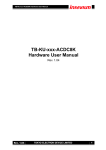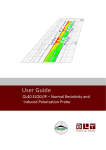Download User`s Manual
Transcript
Xen Zynq Distribution User’s Manual - BETA Xilinx-XenZynq-DOC-0001 v0.2 September 25, 2015 Revision History The following table shows the revision history for this document. Date Version DD/MM/YYYY Changes 30/03/2015 0.1 Converted Alpha Release Document using the Xilinx Template 4/22/2015 0.2 Updated steps and release to work with the beta version of petalinux 6/22/2015 0.3 Fixed the numbering scheme and added a section on non linux guests Table of Contents Chapter 1 Introduction.........................................................................................................................................5 1.1. Introduction to the Xilinx Zynq UltraScale+ Multiprocessor System-on-Chip (MPSoC) Platform.........................5 1.2. Introduction to Xen Zynq Distribution ...........................................................................................................5 Chapter 2 2.1. Section To Be Written ..................................................................................................................................6 Chapter 3 3.1. 3.2. 3.3. 3.3.1. 3.3.2. 3.4. 3.4.1. 3.4.2. 3.4.3. Host Setup - QEMU ..............................................................................................................................7 QEMU Introduction......................................................................................................................................7 Release Image .............................................................................................................................................7 Setting up host OS .......................................................................................................................................7 Required Tools .........................................................................................................................................8 Required Libraries ....................................................................................................................................8 Installing the Image......................................................................................................................................8 Booting the emulated System ................................................................................................................. 10 Booting a subdomain.............................................................................................................................. 13 Copying a guest...................................................................................................................................... 14 Chapter 4 4.1. 4.2. 4.3. 4.4. 4.5. Board Setup .........................................................................................................................................6 Building From Source ......................................................................................................................... 17 Environment Setup and Build Process ......................................................................................................... 17 Build Dom0 Linux Kernel, Xen, U-Boot, & FSBL............................................................................................. 17 Build the Dom0 File System ........................................................................................................................ 18 Build Device Tree Blob ............................................................................................................................... 19 Building and Installing the Guest................................................................................................................. 19 4.5.1. Build the Guest Domain Kernel ............................................................................................................ 19 4.5.2. Build the Guest Domain File System..................................................................................................... 20 4.5.3. Install the Guest Images into the Dom0 File System .............................................................................. 20 4.6. 4.7. 4.8. Converting dom0 File System Image ........................................................................................................... 22 Running the System ................................................................................................................................... 22 Creating more guests ................................................................................................................................. 23 Chapter 5 Target Board ...................................................................................................................................... 24 5.1. Section To Be Written ................................................................................................................................ 24 Chapter 6 Xen on Zynq....................................................................................................................................... 25 User’s Manual - BETA www.dornerworks.com Xilinx-XenZynq-DOC-0001 v0.2 September 25, 2015 3 6.1. Xen Boot Process ....................................................................................................................................... 25 6.2. xl – Interfacing to Xen ................................................................................................................................ 25 6.2.1. Listing Domains...................................................................................................................................... 25 6.2.2. Creating a guest domain ......................................................................................................................... 25 6.2.3. Shutting down or destroying a guest domain ........................................................................................... 26 6.2.4. Switching between domains ................................................................................................................... 26 Chapter 7 7.1. 7.2. Adding a new guest to the XZD ................................................................................................................... 27 Starting the new guest ............................................................................................................................... 28 Chapter 8 8.1. Interacting with I/O Devices............................................................................................................... 29 Section To Be Written ................................................................................................................................ 29 Chapter 9 9.1. A New Guest...................................................................................................................................... 27 Troubleshooting................................................................................................................................. 30 Section To Be Written ................................................................................................................................ 30 Chapter 10 Additional Support Solutions.............................................................................................................. 31 10.1. Current Support Options......................................................................................................................... 31 User’s Manual - BETA www.dornerworks.com Xilinx-XenZynq-DOC-0001 v0.2 September 25, 2015 4 Chapter 1 Introduction 1.1. Introduction to the Xilinx Zynq UltraScale+ Multiprocessor System-on-Chip (MPSoC) Platform The Xilinx Zynq UltraScale+ Multiprocessor System-on-Chip (MPSoC) is a fully featured processing platform. Xilinx provides an overview of the Zynq UltraScale+ MPSoC here, zynq-ultrascale-mpsoc. The Zynq UltraScale+ MPSoC has many advanced features including a quad core ARM Cortex-A53, a dual core ARM Cortex–R5, the Mali-400MP2 GPU, and a highly configurable FPGA fabric. For more information on the ARM Cortex-A53, please visit cortex-a53-processor. The Zynq UltraScale+ MPSoC is capable of running the open source hypervisor Xen. Details on the Xen hypervisor are located at this web site, xenproject. These features make the new Zynq UltraScale+ MPSoC a strong choice for embedded applications, including aerospace & defense, medical, industrial, telecom, and many other application spaces. 1.2. Introduction to Xen Zynq Distribution Xilinx Xen is the port of the Xen open source hypervisor, for the Xliinx Zynq UltraScale+ MPSoC. Xen is a type 1, or bare metal, hypervisor that can run on Intel and ARM platforms with hypervisor hardware extensions. Xen provides the ability to run multiple operating systems on the same computing platform. Among the many uses of Xen, it allows the system designer to combine computing platforms into a single platform, conserving size, weight, and power (SWaP). Xilinx has ported the Xen hypervisor to run on the Zynq UltraScale+ MPSoC . The Xen Zynq Distribution is released under the GNU General Public License version 2 (GPL2). You are free to use the Xen Zynq Distribution in any manner you see fit. You are free to make modifications and use them privately, without ever releasing them. If you decide to release any modifications to the p ublic in some way, the license requires that you make the modified source code available to the program’s users. In addition to reducing SwaP, there are further advantages to using a hypervisor. Additional benefits are gained when using a hypervisor in applications that require a high level of safety and security. A hypervisor has the ability to isolate operating systems (OS) and provide the capability to run on a system where various OS have a different level of safety requirement or certification. Adding new applications in a new OS would theoretically only need to be certified as opposed to requiring the entire system to be certified again. Security in a hypervisor can be designed in a similar fashion. Using a hypervisor, one can isolate various level s of security from each other, keeping confidential, secret, and top secret data from being accessible to unauthorized users virtual machines. Additionally, certification costs can be reduced as only the new application and OS needs to be certified since the hypervisor provides strict isolation between the OS. Another benefit of a hypervisor that might not be immediately apparent is in designing systems where legacy applications and OS are not trusted and might lead to unexpected crashes. A bug causing a crash in an application or even in an OS will not interfere with the other applications and OS running in different virtual machines. User’s Manual - BETA www.dornerworks.com Xilinx-XenZynq-DOC-0001 v0.2 September 25, 2015 5 Chapter 2 2.1. Board Setup Section To Be Written When the Zynq UltraScale+ MPSoC hardware is ready for release and shipped to customers, this chapter will contain instructions on how to setup the Zynq UltraScale+ MPSoC board. User’s Manual - BETA www.dornerworks.com Xilinx-XenZynq-DOC-0001 v0.2 September 25, 2015 6 Chapter 3 3.1. Host Setup - QEMU QEMU Introduction QEMU is used to emulate and virtualize hardware on a host computer. This allows a user to create and test software against the UltraScale+ MPSoC architecture. In many cases, access to actual hardware may be limited and using a virtualized system provides a significant cost savings while enabling the embedded engineer to develop applications specific for the hardware platform. QEMU is capable of emulating hardware ranging from x86 to PowerPC and, and in this case, ARM processors. One can download the QEMU source code and build fo r any number of supported hardware architectures. The Xen Zynq Distribution environment consists of a version of QEMU built specifically for the Zynq UltraScale+ MPSoC processor. When the development system setup described in section 4 is started, a QEMU instance boots and is passed arguments that tell QEMU to emulate the quad core ARM Cortex -A53 hardware for the Zynq UltraScale+ MPSoC. 3.2. Release Image The release image is a compressed TAR archive. The archive contains a prepackaged image that will allow the engineer to run the Xen hypervisor with a set of prepackaged domains. The figure below illustrates the contents of the beta release image with the included components needed to run the development system. Once the archive is unpackaged, the directory structure will contain the following structure. XenZynqDist-Beta_04_17_2015 o dist hw-description images linux subsystems o XenZynqDist-Beta_04_17_2015.bsp 3.3. Setting up host OS These instructions are intended to be run on an x86_64 Ubuntu 12.04 host. User’s Manual - BETA www.dornerworks.com Xilinx-XenZynq-DOC-0001 v0.2 September 25, 2015 7 Host Setup - QEMU 3.3.1. Required Tools You will need git, several tools in Ubuntu’s build-essential package, and others to complete this build process. $ sudo apt-get install -y build-essential git mercurial dos2unix gawk tftpd-hpa flex bison unzip 3.3.2. Required Libraries Install these additional libraries prior to PetaLinux installation. Library Ubuntu Package Name ncurses terminal library ncurses-dev 32-bit zlib compression library lib32z1 32-bit GCC support library lib32gcc1 32-bit ncurses lib32ncurses5 32-bit Standard C++ library lib32stdc++6 32-bit selinux library libselinux1:i386 $ sudo apt-get install -y ncurses-dev lib32z1 lib32gcc1 lib32ncurses5 lib32stdc++6 libselinux1:i386 3.4. Installing the Image There should be at least 10GB of free disk space available to decompress the archive and run the included scripts. The following setup was tested on an x84_64 PC running native Ubuntu 12.04 with 6 Gb DDR2 Memory, and a Core 2 Quad Q6600 processor. If a developer wants to install/run the beta: 1. Copy the release image to an appropriate location on the host system. 2. Open a bash terminal on the host system, and navigate to the image’s location. 3. Extract the image into the directory with the following command: $ tar -xvzf XenZynqDist-Beta_04_17_2015.tgz 4. Create an envirnronment variable, $RELEASE_DIR $ export RELEASE_DIR=`pwd`/XenZynqDist-Beta_04_17_2015 5. One should also install the petalinux tools. The petalinux build environment requires that you link /bin/sh to /bin/bash. User’s Manual - BETA www.dornerworks.com Xilinx-XenZynq-DOC-0001 v0.2 September 25, 2015 8 Host Setup - QEMU $ cd /bin $ sudo rm sh $ sudo ln -s bash sh 6. Close, and reopen your terminal. 7. Reset the RELEASE_DIR variable $ export RELEASE_DIR=`pwd`/XenZynqDist-Beta_04_17_2015 8. Download petalinux-v2015.SW_Beta2-final-installer.run from the Xilinx Early Access Lounge to the $RELEASE_DIR directory. 9. Once downloaded, the petalinux installer must be made executable. $ cd $RELEASE_DIR $ chmod u+x petalinux-v2015.SW_Beta2-final-installer.run 10. Install petalinux in your release directory by running the following command (This will require accepting a license agreement). $ ./petalinux-v2015.SW_Beta2-final-installer.run 11. Once petalinux is installed, source the petalinux script using the following command. $ source petalinux-v2015.SW_Beta2-final/settings.sh 12. Create tftpboot folder and install prebuilt binaries using the following commands $ sudo mkdir -p /tftpboot $ sudo chmod 777 /tftpboot $ cp $RELEASE_DIR/dist/images/linux/* /tftpboot/ User’s Manual - BETA www.dornerworks.com Xilinx-XenZynq-DOC-0001 v0.2 September 25, 2015 9 Host Setup - QEMU 3.4.1. Booting the emulated System 1. Once the images have been installed correctly, they can be booted using QEMU. Boot QEMU using the following commands: $ cd $RELEASE_DIR/dist $ petalinux-boot --qemu --u-boot --qemu-args "-drive file=images/dom0.qcow,format=qcow2,id=sata-drive -device ide-drive,drive=satadrive,[email protected]" Running the command above will start the prepackaged images on the target machine. In this case the target is QEMU, running on the host computer. While the script is running, there will be kernel messages written to the stdout. They can be ignored. Executing the command will boot a QEMU system which emulates the Zynq UtraScale+ MPSoC, and necessary hardware. Once the emulated system is initialized, it will load the first stage boot loader (FSBL), which bootstraps the second stage boot loader, U-Boot, in QEMU’s memory (RAM). The script will then load the dom0 file system as a virtual hard drive. At this point, QEMU will start booting the emulated Zynq UltraScale+ MPSoC. Once the FSBL has completed, U-Boot then takes over and loads the Xen kernel followed by the dom0 kernel. To accomplish this, U-Boot transfers the Xen kernel, the Xen device tree blob (DTB), and the dom0 kernel into QEMU’s RAM. Once the images have been placed in memory and Xen has booted, boot up responsibilities transfer to Xen whose main priority is booting the dom0 kernel. The script passes in the dom0.img file to QEMU as a SATA device, and then QEMU uses that to emulate the hard drive. Once all of the above has been completed you will be presented with the dom0 login prompt. 2. Log into the system using root/root as the username and password. Once these steps have been completed, Xen and a virtual machine, specifically a Linux dom0 will be running on an emulated Xilinx UltraScale+ MPSoC. The image in Figure 2 visually shows the QEMU setup with Xen and the two domains included in the setup that we are walking through here. User’s Manual - BETA www.dornerworks.com Xilinx-XenZynq-DOC-0001 v0.2 September 25, 2015 10 Host Setup - QEMU Figure 2. System Architecture Now that QEMU has booted the emulated hardware, we need to make sure that Xen is running on the emulated hardware. To test that Xen is running and display diagnostic information, use the ‘xl info’ command. The expected output is shown on the following page. User’s Manual - BETA www.dornerworks.com Xilinx-XenZynq-DOC-0001 v0.2 September 25, 2015 11 Host Setup - QEMU [root@xilinx-buildroot ~]# xl info host : xilinx-buildroot release : 3.18.0+ version : #1 SMP Mon Mar 23 16:24:25 EDT 2015 machine : aarch64 nr_cpus : 1 max_cpu_id : 127 nr_nodes : 1 cores_per_socket : 1 threads_per_core : 1 cpu_mhz : 50 hw_caps : 00000000:00000000:00000000:00000000:00000000:00000000:00000000:00000000 virt_caps : total_memory : 1024 free_memory : 478 sharing_freed_memory : 0 sharing_used_memory : 0 outstanding_claims : 0 free_cpus : 0 xen_major : 4 xen_minor : 6 xen_extra : .0-unstable xen_version : 4.6.0-unstable xen_caps : xen-3.0-aarch64 xen-3.0-armv7l xen_scheduler : credit xen_pagesize : 4096 platform_params : virt_start=0x200000 xen_changeset : Fri Jul 25 14:45:19 2014 +1000 git:b7c4d71 xen_commandline : console=dtuart dtuart=serial0 dom0_mem=512M bootscrub=0 timer_slop=0 cc_compiler : aarch64-buildroot-linux-gnu-gcc (Buildroot 2015.02-rc1-dirty) 4 cc_compile_by : arlx cc_compile_domain : cc_compile_date : Mon Mar 23 16:03:02 EDT 2015 xend_config_format : 4 If Xen is not properly installed or running, you will receive an error similar to: xl: command not found If you receive this error, then your terminal context is most likely not in the QEMU emulated environment. Make sure QEMU’s terminal is in focus. If you continue to receive error, then you have booted a QEMU emulated system without Xen somehow. Please re-extract the release image, and try again. To view the list of running domains, use the ‘xl list’ command # xl list Output: Name dom0 ID 0 Mem VC PUs 512 1 State r ----- Time(s) 133.4 You are now free to test and experiment on the QEMU emulated system! User’s Manual - BETA www.dornerworks.com Xilinx-XenZynq-DOC-0001 v0.2 September 25, 2015 12 Host Setup - QEMU 3.4.2. Booting a subdomain The necessary components for your first subdomain (guest) have already been created. They are stored in dom0’s file system: Component Guest Linux Kernel Guest File System Image Guest Domain Configuration Location in dom0’s file system /root/Dom1-Kernel /root/Dom1.img /etc/xen/dom1.cfg Staying in the QEMU terminal, we will prepare to run a guest domain. The additional domain is already included in the archive we have been working with and will now prepare to run it on the Xen hypervisor. To do that type the following commands in dom0’s console: 1. Mount the guest’s file system to a loop device in domain 0. # losetup /dev/loop0 /root/Dom1.img You should receive no output if the command succeeds. 2. Boot another domain (dom1), and connect to its console # xl create -c /etc/xen/dom1.cfg The -c flag will automatically attach dom1’s console. That is, once this command is executed, you will be logging into dom1. In order to return to dom0’s console while leaving the guest (dom1) running, you can press CTRL-] to get back to dom0. 3. Login using ‘root’ and ‘root’ for the username and password. Since your guest is not a privileged domain, typing ‘xl info’ will output less detailed information, and ‘xl list’ will generate an error as it can only be run in dom0. # xl info Output: host : (none) release : 3.18.0+ version : #1 SMP Tue Feb 24 13:00:31 EST 2015 machine : aarch64 libxl: error: libxl.c:5044:libxl_get_physinfo: getting physinfo: Operation not permitted libxl_physinfo failed. libxl: error: libxl.c:5534:libxl_get_scheduler: getting domain info list: Operation not permitted xen_major : 4 xen_minor : 6 xen_extra : .0-unstable xen_version : 4.6.0-unstable xen_caps : xen-3.0-aarch64 xen-3.0-armv7l xen_scheduler : (null) xen_pagesize : 4096 platform_params : virt_start=0x200000 xen_changeset : Tue Feb 24 22:48:17 2015 +1000 git:03e2f92 xen_commandline : console=dtuart dtuart=serial0 dom0_mem=512M bootscrub=0 timer_slop=0 cc_compiler : aarch64-buildroot-linux-gnu-gcc (Buildroot 2015.02-rc1-dirty) 4 cc_compile_by : arlx User’s Manual - BETA www.dornerworks.com Xilinx-XenZynq-DOC-0001 v0.2 September 25, 2015 13 Host Setup - QEMU cc_compile_domain cc_compile_date xend_config_format : : Fri Mar 13 15:46:51 EDT 2015 : 4 # xl list Output: libxl: error: libxl.c:669:libxl_list_domain: getting domain info list: Operation not permitted libxl_list_domain failed. The system is now running Xen and two domains or virtual machines: dom0 and dom1. If you want to return to dom0’s console while leaving the guest running, you may press CTRL-]. This will close the internal console connection, and bring dom0 back into focus within QEMU’s terminal. To reconnect to a guest terminal, use the “xl console” command [root@xilinx-buildroot ~]# xl console dom1 It is important that you are aware which guest you are issuing commands to. Pay careful attention to the hostname listed in the terminal: [root@xilinx-buildroot ~]# [root@(none) ~]# 3.4.3. dom0 dom1 Copying a guest Both dom0 (control) and dom1 (guest) are included in the archive. You can easily boot a second guest domain, for a total of three domains including dom0, by making copies of dom1’s components. 1. Make sure that domain 1 is powered down before we copy its kernel and file system. [root@xilinx-buildroot ~]# xl console dom1 [root@(none) ~]# poweroff The guest will shutdown, and the system should return to domain0’s console automatically. Make sure that the guest is completely shutdown by using the ‘xl list’ command. Dom1 should NOT have an entry. If you do see an entry for dom1, then this means that dom1 is still shutting down. Wait for approximately 15 or 20 seconds and try the command again. The results should appear similar to the below output. [root@xilinx-buildroot ~]# xl list Output: Name dom0 ID 0 Mem VCPUs State Time(s) 512 1 r ----259.7 2. Copy the dom1 FS image. [root@xilinx-buildroot ~]# cp /root/Dom1.img /root/Dom2.img This file is 1Gb, and will take a while to copy on the emulated SATA device. 3. Copy the dom1 kernel. User’s Manual - BETA www.dornerworks.com Xilinx-XenZynq-DOC-0001 v0.2 September 25, 2015 14 Host Setup - QEMU [root@xilinx-buildroot ~]# cp /root/Dom1 -Kernel /root/Dom2-Kernel 4. Copy the dom1 configuration file. [root@xilinx-buildroot ~]# cp /etc/xen/dom1.cfg /etc/xen/dom2.cfg 5. Edit the new dom2 configuration file. You will need to: a. Rename the guest to be named dom2. b. Configure the guest to boot domain 2’s kernel. c. Change the targeted loop device to allow two domains to run simultaneously. You can accomplish this change using vi or sed expressions. [root@xilinx-buildroot ~]# vi /etc/xen/dom2.cfg or [root@xilinx-buildroot ~]# sed -i 's/om1/om2/' /etc/xen/dom2.cfg [root@xilinx-buildroot ~]# sed -i 's/loop0/loop1/' /etc/xen/dom2.cfg 6. Verify that the changes have been made to the appropriate files. [root@xilinx-buildroot ~]# cat /etc/xen/dom2.cfg # ===================================================================== # Example PV Linux guest configuration # ===================================================================== ... # Guest name name = "dom2" ... # Kernel image to boot kernel = "/root/Dom2-Kernel" ... # Disk Devices # A list of `diskspec' entries as described in # docs/misc/xl-disk-configuration.txt disk = [ 'phy:/dev/loop1,xvda,w' ] 7. Mount the guest file systems to their respective loop devices in domain 0. The losetup command creates a device on which we can mount the file systems created. # If you have already mounted /root/Dom1.img to /dev/loop0, # there is no need to mount it again [root@xilinx-buildroot ~]# losetup /dev/loop0 /root/Dom1.img # The dom2 filesystem hasn’t been mounted yet: [root@xilinx-buildroot ~]# losetup /dev/loop1 /root/Dom2.img 8. Start the domains (or virtual machines) with the following commands. [root@xilinx-buildroot ~]# xl create /etc/xen/dom1.cfg User’s Manual - BETA www.dornerworks.com Xilinx-XenZynq-DOC-0001 v0.2 September 25, 2015 15 Host Setup - QEMU When you leave the -c flag off of the domain creation command, you will receive the guests initial boot messages to dom0’s standard out, while also keeping dom0’s console in focus. This chatter does not affect your standard input however it does make it a bit hard to type the next command. You might want to wait before issuing the next command. The last message should look similar to the below output (the ‘3’ in the vif3.0 output is variable). ... xenbr0: port 2(vif3.0) entered forwarding state xenbr0: port 2(vif3.0) entered forwarding state xenbr0: port 2(vif3.0) entered forwarding state Hit enter to bring up a new line in the console, indicating your hostname. Make sure you are still in dom0’s console, and that you didn’t attach to the guest. [root@xilinx-buildroot ~]# [root@xilinx-buildroot ~]# xl create /etc/xen/dom2.cfg You should see similar console chatter from dom2 booting as it reports to standard out. The ‘xl list’ command will now show all three domains running. The ID values are sequential and will increase each time a domain is created. The ID numbers here might look different in your output. [root@xilinx-buildroot ~]# xl list Name dom0 dom1 dom2 ID 0 1 2 Mem VCPUs 512 1 128 1 128 1 State r-----b----b---- Time(s) 378.0 67.8 46.5 Guest domains should be shutdown carefully, as their file systems are easily corrupted if they are reset improperly or shutdown in the middle of an IO operation. There are two methods to shutdown a guest: From domain0, you can request the Xen Kernel to send a shutdown signal to a guest: [root@xilinx-buildroot ~]# xl shutdown dom1 You could also attach to dom1’s console by executing the command ‘xl console dom1’ and send the poweroff command: # To attach to dom1’s console [root@xilinx-buildroot ~]# xl console dom1 # While in dom1 [root@(none) ~]# poweroff The poweroff command will function as expected within dom0’s console as well, but you should make sure that all domains are properly shutdown before doing so. [root@xilinx-buildroot ~]# poweroff Once all the domains have been shutdown, you may terminate the instance of QEMU using the keyboard shortcut CTRL-A X. (Control-A, release, then X) View other QEMU shortcuts by typing CTRL-A H (Control-A, release, then H, while QEMU is running). User’s Manual - BETA www.dornerworks.com Xilinx-XenZynq-DOC-0001 v0.2 September 25, 2015 16 Chapter 4 4.1. Building From Source Environment Setup and Build Process If you have not executed the steps in section 3.4, in a terminal, set RELEASE_DIR to the directory path where the archive was decompressed. This variable will be used in several instructions so that you may cop y-paste them. $ export RELEASE_DIR=`pwd`/XenZynqDist-Beta_04_17_2015 4.2. Build Dom0 Linux Kernel, Xen, U-Boot, & FSBL The following instructions assume that you are using the provided petalinux and qemu binaries. TIP: If you have not extracted the release, please visit chapter 3 - section 3 and follow the steps to decompress the archive into a directory. If you have not installed the petalinx tools, please refer to section 3.3. 1. Once petalinux is installed, source the petalinux script using the following command. $ cd $RELEASE_DIR $ source petalinux-v2015.SW_Beta2-final/settings.sh 2. Create a project directory named ‘XenZynqDist’ using the BSP provided: $ petalinux-create -t project -s XenZynqDist-Beta_04_17_2015.bsp -n XenZynqDist This project directory should have everything you need to build the Xen Zynq distribution. 3. Enter the project directory $ cd $RELEASE_DIR/XenZynqDist 4. (Optional) If there is a need to configure the dom0 kernel, you can run the command below and select the features that need to be added. Added kernel configurations are beyond the scope of this document and should only be done if there is a specific reason. The default configuration will be sufficient to run as the dom0 kernel for this exercise. # (This command is optional) $ petalinux-config -c kernel 5. Use petalinux to build the linux kernel, xen, U-Boot, and FSBL images. $ petalinux-build User’s Manual - BETA www.dornerworks.com Xilinx-XenZynq-DOC-0001 v0.2 September 25, 2015 17 Building From Source TIP: If you want more information during the build, you can use the verbose flag ‘–v’ with the petalinux-build command. 6. View your images in the ‘images/linux/’ directory $ ls images/linux/ bl31.bin Image s.srec xen.ub bl31.elf image.elf zynqmp_fsbl.elf 4.3. image.ub System.map.linux u -boot.elf u-boot-s.elf u-boot- system.dtb u -boot.bin u-boot-s.bin u-boot.srec vmlinux Build the Dom0 File System These instructions build the file system (FS) for the system domain, Dom0. 7. Clone the buildroot source and create the default configuration file for the Dom0 FS. $ $ $ $ cd $RELEASE_DIR git clone https://github.com/dornerworks/buildroot.git -b xen-guest-fs cd buildroot make zynq_ultra_mpsoc_dom0_defconfig 8. Run the menuconfig tool if there is specific functionality that needs to be built into the FS. # (This command is optional) $ make menuconfig 9. Once your configuration is complete, build the FS. $ make The make may run for up to one hour depending on the host system specifications. The make command generates a FS tarball called rootfs.tar in the following location: $ ls $RELEASE_DIR/buildroot/output/images rootfs.cpio rootfs.cpio.gz rootfs.tar 10. Copy package configuration within buildroot $ cp $RELEASE_DIR/buildroot/output/host/usr/bin/pkg-config $RELEASE_DIR/buildroot/output/host/usr/bin/aarch64-buildroot-linux-gnu-pkg-config 11. Add buildroot compiler to your path $ export PATH=$PATH:$RELEASE_DIR/buildroot/output/host/usr/bin/ 12. Configure and build the Xen tools $ cd $RELEASE_DIR/XenZynqDist/components/apps/xen/xen-src $ ./configure --host=aarch64-buildroot-linux-gnu --enable-tools $ make dist-tools CROSS_COMPILE=aarch64-buildroot-linux-gnu- XEN_TARGET_ARCH=arm64 CONFIG_EARLY_PRINTK=ronaldo 13. Add the Xen tools to buildroot $ cd $RELEASE_DIR User’s Manual - BETA www.dornerworks.com Xilinx-XenZynq-DOC-0001 v0.2 September 25, 2015 18 Building From Source $ cp $RELEASE_DIR/buildroot/output/images/rootfs.tar dom0.rootfs.tar $ fakeroot tar -rvf dom0.rootfs.tar --transform='s,usr/lib64,usr/lib,S' -transform='s,var/log,tmp,S' --show-transformed-names C$RELEASE_DIR/XenZynqDist/components/apps/xen/xen -src/dist/install ./etc/ C$RELEASE_DIR/XenZynqDist/components/apps/xen/xen -src/dist/install ./usr/ C$RELEASE_DIR/XenZynqDist/components/apps/xen/xen -src/dist/install ./var/ 14. Create and partition the dom0 image file: $ dd if=/dev/zero of=$RELEASE_DIR/XenZynqDist/images/dom0.img bs=1G count=8 $ echo -e "n\np\n1\n\n\nt\n83\nw\n" | fdisk $RELEASE_DIR/XenZynqDist/images/dom0.img 15. Mount and format the Dom0 image file: $ $ $ $ sudo losetup -o 1048576 /dev/loop0 $RELEASE_DIR/XenZynqDist/images/dom0.img sudo mkfs.ext2 /dev/loop0 mkdir -p $RELEASE_DIR/tmp/dom0_fs sudo mount /dev/loop0 $RELEASE_DIR/tmp/dom0_fs 16. Install the Dom0 FS onto the image file: $ sudo tar -xvf dom0.rootfs.tar -C $RELEASE_DIR/tmp/dom0_fs 17. Unmount the Dom0 image file: $ sudo umount /dev/loop0 $ sudo losetup -d /dev/loop0 4.4. Build Device Tree Blob 1. Create the device tree blob (DTB) $ dtc -I dts -O dtb -o /tftpboot/xen.dtb $RELEASE_DIR/xen.dts 4.5. Building and Installing the Guest 4.5.1. Build the Guest Domain Kernel If the guest kernel does not need to be configured differently from the dom0 kernel, then one can skip to step 5 in this section. 1. Change directory to the Xen Zynq Distribution $ cd $RELEASE_DIR/XenZynqDist 2. Configure the guest kernel $ petalinux-config -c kernel 3. Build a new kernel $ petalinux-build -c kernel 4. Assemble the kernel image # Assemble the image: User’s Manual - BETA www.dornerworks.com Xilinx-XenZynq-DOC-0001 v0.2 September 25, 2015 19 Building From Source $ petalinux-build -x package 5. Copy the guest linux kernel image $ cp $RELEASE_DIR/XenZynqDist/images/linux/Image $RELEASE_DIR/Dom1-Kernel 4.5.2. Build the Guest Domain File System 1. Change to the $RELEASE_DIR/buildroot directory. Create the default configuration file for a guest FS. $ cd $RELEASE_DIR/buildroot $ make zynq_ultra_mpsoc_guest_defconfig 2. Run the menuconfig tool if there is specific functionality that needs to be built into the FS. $ make menuconfig 3. Once your configuration is complete, build the FS. $ make The make command generates a FS tarball called rootfs.tar in the following location: $ ls $RELEASE_DIR/buildroot/output/images rootfs.cpio rootfs.cpio.gz rootfs.tar 4. If the Xen tools are not built, then follow the steps to build the Xen-Tools in the step Configure and build the Xen tools to create the tools. Following this, then execute the command below. $ cd $RELEASE_DIR $ cp $RELEASE_DIR/buildroot/output/images/rootfs.tar dom1.rootfs.tar $ fakeroot tar -rvf dom1.rootfs.tar --transform='s,usr/lib64,usr/lib,S' -transform='s,var/log,tmp,S' --show-transformed-names C$RELEASE_DIR/XenZynqDist/components/apps/xen/xen -src/dist/install ./etc/ C$RELEASE_DIR/XenZynqDist/components/apps/xen/xen -src/dist/install ./usr/ C$RELEASE_DIR/XenZynqDist/components/apps/xen/xen -src/dist/install ./var/ 4.5.3. Install the Guest Images into the Dom0 File System To construct the configuration files for a new domain and then insert those files into the dom0 File system, follow the steps below: 1. Attach dom0’s FS to a loop device, and mount it to a temporary directory. $ $ $ $ cd $RELEASE_DIR sudo losetup -o 1048576 /dev/loop0 $RELEASE_DIR/XenZynqDist/images/dom0.img mkdir -p $RELEASE_DIR/tmp/dom0_fs sudo mount /dev/loop0 $RELEASE_DIR/tmp/dom0_fs 2. Move the Dom1-Kernel into dom0’s filesystem. $ sudo mv $RELEASE_DIR/Dom1-Kernel $RELEASE_DIR/tmp/dom0_fs/root/Dom1-Kernel 3. Create a configuration file for your DomU. Below is the configuration file for Dom1. It contains additional options that will not be used in the rest of the demonstration. Move to the following directory and insert the following file in your desired manner: $ cd $RELEASE_DIR/tmp/dom0_fs/etc/xen/ User’s Manual - BETA www.dornerworks.com Xilinx-XenZynq-DOC-0001 v0.2 September 25, 2015 20 Building From Source # # # # # # ===================================================================== Example PV Linux guest configuration ===================================================================== This is a fairly minimal example of what is required for a Paravirtualised Linux guest. For a more complete guide see xl.cfg(5) # Guest name name = "dom1" # 128-bit UUID for the domain as a hexadecimal number. # Use "uuidgen" to generate one if required. # The default behavior is to generate a new UUID each time the guest is started. #uuid = "XXXXXXXX-XXXX-XXXX-XXXX-XXXXXXXXXXXX" # Kernel image to boot kernel = "/root/Dom1-Kernel" # Kernel command line options extra = "console=hvc0 earlyprintk=xenboot root=/dev/xvda1 rw" # Initial memory allocation (MB) memory = 128 # Maximum memory (MB) # If this is greater than `memory' then the slack will start ballooned # (this assumes guest kernel support for ballooning) #maxmem = 512 # Number of VCPUS vcpus = 1 # Network devices # A list of 'vifspec' entries as described in # docs/misc/xl-network-configuration.markdown vif = [ 'bridge=xenbr0' ] # Disk Devices # A list of `diskspec' entries as described in # docs/misc/xl-disk-configuration.txt disk = [ 'phy:/dev/loop0,xvda,w' ] TIP: Each domain requires a configuration file that Xen can use to boot the domain. The configuration files are generally located in /etc/xen, however they can be located anywhere one chooses. 4. Create a blank 1Gb file to be used as the Guest’s (Dom1’s) FS Image Take note of the Output File name (of=<Name>) you are choosing in the following command: $ sudo dd if=/dev/zero of=$RELEASE_DIR/tmp/dom0_fs/root/Dom1.img bs=1M count=1024 $ cd $RELEASE_DIR User’s Manual - BETA www.dornerworks.com Xilinx-XenZynq-DOC-0001 v0.2 September 25, 2015 21 Building From Source 5. Create a partition table on the image, and use the entire image file as a Linux partition $ sudo sh -c 'echo -e "n\np\n1\n\n\nt\n83\nw\n" | fdisk tmp/dom0_fs/root/Dom1.img' 6. Make a temporary mounting directory for the Guest FS image. $ mkdir -p $RELEASE_DIR/tmp/dom1_fs 7. Attach the Guest FS image to a loop device. $ sudo losetup -o 1048576 /dev/loop1 $RELEASE_DIR/tmp/dom0_fs/root/Dom1.img 8. Format the Guest FS image using ‘mkfs.ext2’ $ sudo mkfs.ext2 /dev/loop1 9. Mount the Guest FS image to the temporary mounting directory. $ sudo mount /dev/loop1 $RELEASE_DIR/tmp/dom1_fs 10. Un-pack the files for the FS. $ sudo tar -xvf dom1.rootfs.tar -C $RELEASE_DIR/tmp/dom1_fs 11. Unmount and detach the Guest and dom0 filesystems. $ sudo umount /dev/loop1 $ sudo losetup -d /dev/loop1 $ sudo umount /dev/loop0 $ sudo losetup -d /dev/loop0 CAUTION! Due to how petalinux currently works, anytime a new guest domain is built that is configured differently from the dom0, a new dom0 must be built as the original one will be over-written 4.6. Converting dom0 File System Image The Dom0 FS image that was created is fairly large as a raw image file. To deal with that, the image is converted to a qcow2 image, which is a compressed image format that QEMU understands. To convert to this format, use the following command: $ qemu-img convert -O qcow2 $RELEASE_DIR/XenZynqDist/images/dom0.im g $RELEASE_DIR/XenZynqDist/images/dom0.qcow $ rm $RELEASE_DIR/XenZynqDist/images/dom0.img 4.7. Running the System 1. Boot QEMU by running the following command $ cd $RELEASE_DIR/XenZynqDist User’s Manual - BETA www.dornerworks.com Xilinx-XenZynq-DOC-0001 v0.2 September 25, 2015 22 Building From Source $ petalinux-boot --qemu --u-boot --qemu-args "-drive file=images/dom0.qcow,format=qcow2,id=sata-drive -device ide-drive,drive=satadrive,[email protected]" 2. Start your customized domain. [root@xilinx-buildroot ~]# losetup /dev/loop0 /root/Dom1.img [root@xilinx-buildroot ~]# xl create /etc/xen/dom1.cfg -c TIP: There are times when the domain is created in a paused state. To correct this problem, enter the following commands below: [root@xilinx-buildroot ~]# xl unpause dom1 [root@xilinx-buildroot ~]# xl console dom1 3. Verify that the new domain is running. [root@xilinx-buildroot ~]# xl list Name dom0 dom1 4.8. ID 0 1 Mem VCPUs 512 1 128 1 State r -----b---- Time(s) 36.7 10.3 Creating more guests To create more guests from source, just follow the steps in section 4.5, but anywhere “Dom1” is used, use the name of the new domain, such as Dom2. When the Dom0 FS image needs to be mounted, make sure to convert the qcow2 formatted image back to a raw formatted image with the following command $ qemu-img convert -O raw $RELEASE_DIR/XenZynqDist/images/dom0.qcow $RELEASE_DIR/XenZynqDist/images/dom0.img User’s Manual - BETA www.dornerworks.com Xilinx-XenZynq-DOC-0001 v0.2 September 25, 2015 23 Target Board Chapter 5 5.1. Target Board Section To Be Written This chapter will discuss how to build for various targets including QEMU and the Zynq UltraScale+ MPSoC. This section will be updated when more details on the hardware become available. User’s Manual - BETA www.dornerworks.com Xilinx-XenZynq-DOC-0001 v0.2 September 25, 2015 24 Chapter 6 6.1. Xen on Zynq Xen Boot Process Running Xen requires booting two kernels: the Xen kernel and the dom0 (or control) kernel, which at this point is a Linux kernel. Both kernels are loaded into the proper memory locations by the boot loader. Once the boot loader has finished the initialization of the system, it passes control of the boot process over to Xen. Xen then performs some additional hardware initialization such as initializing the Zynq hardware so that Xen can map and handle requests from the device drivers used by the dom0 kernel. More details on the Xen boot process can be found on the Xen Wiki (http://www.xenproject.org/help/wiki.html). Once Xen performs its initialization, it then loads the dom0 (usually Linux) kernel and the RAM disk into memory. The dom0 kernel is then booted by Xen inside the privileged virtual machine domain; from the perspective of the kernel and the user this boot process is identical to Linux booting directly on the system hardware. Once dom0 has booted, access to Xen can be configured for each unprivileged domain via the dom0 interface to Xen. Dom0 has special privileges allowing it to perform this configuration, among them being the ability to access the system hardware directly. It also runs the Xen management toolstack, briefly described below. 6.2. xl – Interfacing to Xen xl provides an interface to interact with Xen. It is the standard Xen project supported toolstack provided with the Xen hypervisor for virtual machine configuration, management, and debugging. 6.2.1. Listing Domains ‘xl list’ is used to list the running domains and their states on the system. # xl list Output: Name Domain-0 dom1 6.2.2. ID 0 1 Mem VCPUs 2048 2 1024 2 State Time(s) r ----32.0 r ----7.3 Creating a guest domain The following command will start a new domain using the provided configuration file a rgument. The name of the domain is determined by the value set in the configuration file. # xl create -c /etc/xen/dom1.cfg User’s Manual - BETA www.dornerworks.com Xilinx-XenZynq-DOC-0001 v0.2 September 25, 2015 25 Xen on Zynq 6.2.3. Shutting down or destroying a guest domain ‘xl shutdown’ is the command that should be used to shut down a running guest domain on the system. It performs a graceful shutdown of the domain using the built-in shutdown features of the domain’s operating system, allowing the domains files system to close safely, and releasing any hardware resources (RAM, CPU Time, etc.) back to the system. # xl shutdown dom1 ‘xl destroy’ Should only be used as a last resort on unresponsive domains that are not removed when given the ‘xl shutdown’ command. The destroy command does not perform a graceful shutdown and potentially could corrupt the guest domain’s file system as well as any I/O devices to which the domain has been given access. # xl destroy dom1 6.2.4. Switching between domains To access the command-line interface of a running domain, use the following command: # xl console <domain-name> where <domain-name> is the name of the specific domain of interest (the names of all running domains can be viewed using the `xl list` command detailed above). To return to the dom0 command-line interface, press the key combination: CTRL-]. User’s Manual - BETA www.dornerworks.com Xilinx-XenZynq-DOC-0001 v0.2 September 25, 2015 26 Chapter 7 7.1. A New Guest Adding a new guest to the XZD There are more than just Linux OS’s available as guests for the Xen Zynq Distribution. This section will go over how to install and run one of these other guests. We will be using the XZD bare metal guest as an example. These instructions assume you have followed Chapter 4 already. First, follow the Xen Zynq Distribution (XZD) Bare Metal Guest How To Guide to successfully build the XZD bare metal guest image, xzd_bare.img. Once you have your built image, it needs to be placed in the dom0 filesystem. To do that, perform the following: 1. Source the Petalinux toolset $ cd $RELEASE_DIR $ source petalinux-v2015.SW_Beta2-final/settings.sh 2. Convert the dom0 FS QCOW2 image to a RAW format $ qemu-img convert -O raw $RELEASE_DIR/XenZynqDist/images/dom0.qcow $RELEASE_DIR/XenZynqDist/images/dom0.img 3. Attach dom0’s FS to a loop device, and mount it to a temporary directory. $ sudo losetup -o 1048576 /dev/loop0 $RELEASE_DIR/XenZynqDist/images/dom0.img $ mkdir -p $RELEASE_DIR/tmp/dom0_fs $ sudo mount /dev/loop0 $RELEASE_DIR/tmp/dom0_fs 4. Move the bare metal image into dom0’s filesystem. $ sudo mv $RELEASE_DIR/xzd_bare.img $RELEASE_DIR/tmp/dom0_fs/root/xzd_bare1.img 5. Create a configuration file for your bare metal guest (/etc/xen/bare1.cfg). Below is an example configuration file. Move to the following directory and insert the following file in your desired manner: $ cd $RELEASE_DIR/tmp/dom0_fs/etc/xen/ # # # # # # ===================================================================== Example bare metal Guest configuration ===================================================================== This is a fairly minimal example of what is required for a Paravirtualised Linux guest. For a more complete guide see xl.cfg(5) # Guest name name = "bare1" # Kernel image to boot kernel = "/root/xzd_bare1.img" User’s Manual - BETA www.dornerworks.com Xilinx-XenZynq-DOC-0001 v0.2 September 25, 2015 27 A New Guest # Initial memory allocation (MB) memory = 128 # Number of VCPUS vcpus = 1 6. Unmount and detach the dom0 filesystem. $ cd $RELEASE_DIR $ sudo umount /dev/loop0 $ sudo losetup -d /dev/loop0 7. Convert the dom0 FS RAW image back to a QCOW2 format $ qemu-img convert -O qcow2 $RELEASE_DIR/XenZynqDist/images/dom0.img $RELEASE_DIR/XenZynqDist/images/dom0.qcow $ rm $RELEASE_DIR/XenZynqDist/images/dom0.img 7.2. Starting the new guest Now that the bare metal guest has been added to the dom0 file system, it can be created as a guest. Follow Section 4.7 to boot the system. After that, start your bare metal guest using the following command: 1. Start your domain. [root@xilinx-buildroot ~]# xl create /etc/xen/bare1.cfg -c You should then see the following on the command line: (d$u) XZD_Bare: Hello World Where $u is the id number of the bare metal guest. User’s Manual - BETA www.dornerworks.com Xilinx-XenZynq-DOC-0001 v0.2 September 25, 2015 28 Interacting with I/O Devices Chapter 8 8.1. Interacting with I/O Devices Section To Be Written When the Zynq UltraScale+ MPSoC documentation is released, this chapter will discuss how to access some of the I/O devices via paravirtualization (pv) or passthrough. Further details on this functionality will be provided at a future release of this document. User’s Manual - BETA www.dornerworks.com Xilinx-XenZynq-DOC-0001 v0.2 September 25, 2015 29 Chapter 9 9.1. Troubleshooting Section To Be Written User’s Manual - BETA www.dornerworks.com Xilinx-XenZynq-DOC-0001 v0.2 September 25, 2015 30 Chapter 10 Additional Support Solutions 10.1. Current Support Options For more information and support, please visit our web site. http://dornerworks.com/services/xilinxxen Details on the Xilinx Zynq UltraScale+ MPSoC can be found here: http://www.xilinx.com/products/silicon-devices/soc/zynq-ultrascale-mpsoc.html User’s Manual - BETA www.dornerworks.com Xilinx-XenZynq-DOC-0001 v0.2 September 25, 2015 31































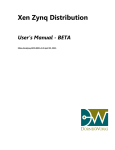
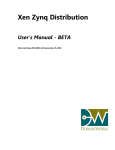
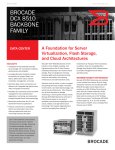
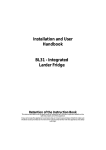
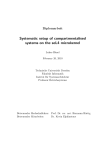

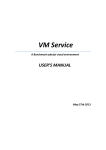
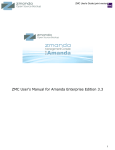
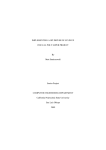
![2008 [DAMN SMALL NAS]](http://vs1.manualzilla.com/store/data/005757702_2-ad0d2f1082977ee9ed587e807bbc0127-150x150.png)
